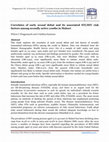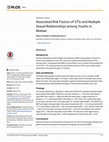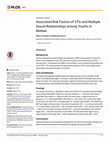Papers by Ningpuanyeh W Chialepeh
Journal of Asian and African Studies, 2016
The purpose of this research is to investigate and analyse higher education institutions’ enrolme... more The purpose of this research is to investigate and analyse higher education institutions’ enrolment and drop-out rates within the Gauteng province, South Africa. Large-scale secondary data from the General Household Survey, obtained from Statistics South Africa (2012) were used. This study’s findings show that finance, orphan-hood, transport to the higher education institutions and, to a lesser extent, unplanned pregnancies, are some of the main factors that affect the enrolment rate of students. This study hopes to be useful to policy-makers, research managers and other decision-makers within the higher education (HE) landscape.

Journal of Asian and African Studies, 2016
This study explores the correlates of early sexual debut and risk factors of sexually transmitted... more This study explores the correlates of early sexual debut and risk factors of sexually transmitted infections (STIs) among the youth in Malawi. Data was obtained from the Malawi Demographic Health Survey 2010. Out of a sample of 2987 males and 9559 females aged 15–24 years, 1405 males and 5217 females were considered. Chi-square and multivariate analysis was performed and findings presented by gender. The results indicate that females aged 15–19 years (OR=4.18), who were Muslims (OR=1.42), with no education (OR=3.99), were significantly more likely to initiate sexual debut early. Meanwhile, males aged 15–19 years (OR=3.50), from the northern region (OR=2.35) and of the Chewa ethnic group (OR=1.45) were significantly more likely to initiate sexual debut early. Muslims males (OR=0.57), from the poorest (OR=0.69) households were significantly less likely to initiate sexual debut early. Females who initiate sex earlier form a distinct risk group in this study. Specific intervention is th...
Scandinavian Journal of Public Health, 2015
Aim: This study focused on the top 10 selected African countries with key interventions such as h... more Aim: This study focused on the top 10 selected African countries with key interventions such as high infant mortality rate, high total fertility rate and female literacy rate. Methods: The World Bank’s 2013 data were used. Descriptive analyses were performed. Results: Findings show that Sierra Leone (107.2), Angola (102) and Central Africa Republic (96.1) reported the highest infant mortality rate per 1000 live births. The total fertility rates in Niger (7.6), Mali (6.8) and Somalia (6.6) were higher than other comparable countries. Conclusions: Health care service providers need to pay more attention during pregnancy periods, improve number of field visits, identify pregnant women and promote 100% antenatal care. If this is done practically, these countries will reduce and ultimately eliminate infant mortality.

Journal of Asian and African Studies, 2015
This study examines the risk associated with inconsistent use of condoms as a risk factor for hum... more This study examines the risk associated with inconsistent use of condoms as a risk factor for human immunodeficiency virus/sexually transmitted infections (HIV/STIs) and sexual risk behaviours. The Malawi Demographic Health Survey 2010 data were used. Out of a sample of 2987 males and 9559 females aged 15–24 years, 511 males and 675 females were filtered in the present study. A Chi square test and logistic regression techniques were performed. About 147(28.7%) males and 240(35.6%) females reported inconsistent condom use. The likelihood of inconsistent condom use was higher among females with secondary/higher education (odds ratio’s (OR)=1.46), with more than one partner (OR=4.27), and married males (OR=8.76), with more than one sex partner (OR=1.78).There is a need to raise condom use awareness and improve sexual education about consistent condom use, especially among females, in order to curb the spread of HIV/STIs and reduce sexual risk behaviours.
Journal of Asian and African Studies, 2014
The sexual behaviour of youths in Malawi is believed to play an important role in the spread of s... more The sexual behaviour of youths in Malawi is believed to play an important role in the spread of sexually transmitted infections (STIs). Relevant data from the Malawi Demographic and Health Survey 2010 and a sample of 16,217 youths aged 15–24 have been studied and subjected to bivariate and logistic regression analysis. The results show that married youths were not interested in using condoms (94.2%, p < 0.05) and that those who were living together were 69 times (OR = 1.69, 95% CI, 1.26–2.26) more likely to be involved in early sexual activity than those who were not living together. It is argued that the results should help other researchers, policy makers and planners to create strategies to encourage these youths make use of contraception.

PloS one, 2015
Having unprotected sex with multiple sexual partners (MSP) is the greatest risk factor for human ... more Having unprotected sex with multiple sexual partners (MSP) is the greatest risk factor for human immunodeficiency virus (HIV) and other sexually transmitted infections (STIs) among youths. Young people with MSPs are less likely to use a condom and the greater the risk for STIs. This study examines the associated risk factors of STIs and multiple sexual partnerships among youths aged 15-24 years. The Malawi Demographic Health Survey 2010 data was used. Out of a sample of 2,987 males and 9,559 females aged 15-24 years, 2,026 males and 6,470 females were considered in the study. Chi square test and logistic regression techniques were performed. Analysis was performed using Statistical Package for Social Sciences (SPSS) version 22. The results indicate that 1,399 (69.0%) males and 2,290 (35.4%) females reported multiple sexual partnerships (MSP). Within the rural area, females (n = 1779) were more likely to report MSP than males (n = 1082) and within the urban areas, a higher proportion...

This study explores the correlates of early sexual debut and risk factors of sexually transmitted... more This study explores the correlates of early sexual debut and risk factors of sexually transmitted infections (STIs) among the youth in Malawi. Data was obtained from the Malawi Demographic Health Survey 2010. Out of a sample of 2987 males and 9559 females aged 15–24 years, 1405 males and 5217 females were considered. Chi-square and multivariate analysis was performed and findings presented by gender. The results indicate that females aged 15–19 years (OR=4.18), who were Muslims (OR=1.42), with no education (OR=3.99), were significantly more likely to initiate sexual debut early. Meanwhile, males aged 15–19 years (OR=3.50), from the northern region (OR=2.35) and of the Chewa ethnic group (OR=1.45) were significantly more likely to initiate sexual debut early. Muslims males (OR=0.57), from the poorest (OR=0.69) households were significantly less likely to initiate sexual debut early. Females who initiate sex earlier form a distinct risk group in this study. Specific intervention is therefore needed for young females in their early teen years before they initiate sexual debut.
The purpose of this research is to investigate and analyse higher education institutions' enrolme... more The purpose of this research is to investigate and analyse higher education institutions' enrolment and drop-out rates within the Gauteng province, South Africa. Large-scale secondary data from the General Household Survey, obtained from Statistics South Africa (2012) were used. This study's findings show that finance, orphan-hood, transport to the higher education institutions and, to a lesser extent, unplanned pregnancies, are some of the main factors that affect the enrolment rate of students. This study hopes to be useful to policy-makers, research managers and other decision-makers within the higher education (HE) landscape.

This study examines the risk associated with inconsistent use of condoms as a risk factor for hum... more This study examines the risk associated with inconsistent use of condoms as a risk factor for human immunodeficiency virus/sexually transmitted infections (HIV/STIs) and sexual risk behaviours. The Malawi Demographic Health Survey 2010 data were used. Out of a sample of 2987 males and 9559 females aged 15–24 years, 511 males and 675 females were filtered in the present study. A Chi square test and logistic regression techniques were performed. About 147(28.7%) males and 240(35.6%) females reported inconsistent condom use. The likelihood of inconsistent condom use was higher among females with secondary/higher education (odds ratio (OR)=1.46), with more than one partner (OR=4.27), and married males (OR=8.76), with more than one sex partner (OR=1.78).There is a need to raise condom use awareness and improve sexual education about consistent condom use, especially among females, in order to curb the spread of HIV/STIs and reduce sexual risk behaviours. Keywords Sexually active youths, inconsistent condom use, sexually risky behaviour, human immunodeficiency virus, Malawi
Aim: This study focused on the top 10 selected African countries with key interventions such as h... more Aim: This study focused on the top 10 selected African countries with key interventions such as high infant mortality rate,
high total fertility rate and female literacy rate. Methods: The World Bank’s 2013 data were used. Descriptive analyses were
performed. Results: Findings show that Sierra Leone (107.2), Angola (102) and Central Africa Republic (96.1) reported the
highest infant mortality rate per 1000 live births. The total fertility rates in Niger (7.6), Mali (6.8) and Somalia (6.6) were
higher than other comparable countries. Conclusions: Health care service providers need to pay more attention
during pregnancy periods, improve number of field visits, identify pregnant women and promote 100% antenatal
care. If this is done practically, these countries will reduce and ultimately eliminate infant mortality.
The sexual behaviour of youths in Malawi is believed to play an important role in the spread of s... more The sexual behaviour of youths in Malawi is believed to play an important role in the spread of sexually
transmitted infections (STIs). Relevant data from the Malawi Demographic and Health Survey 2010 and a
sample of 16,217 youths aged 15–24 have been studied and subjected to bivariate and logistic regression
analysis. The results show that married youths were not interested in using condoms (94.2%, p < 0.05)
and that those who were living together were 69 times (OR = 1.69, 95% CI, 1.26–2.26) more likely to be
involved in early sexual activity than those who were not living together. It is argued that the results should
help other researchers, policy makers and planners to create strategies to encourage these youths make
use of contraception.

This study examines the risk associated with inconsistent use of condoms as a risk factor for hum... more This study examines the risk associated with inconsistent use of condoms as a risk factor for human
immunodeficiency virus/sexually transmitted infections (HIV/STIs) and sexual risk behaviours. The Malawi
Demographic Health Survey 2010 data were used. Out of a sample of 2987 males and 9559 females aged 15–24
years, 511 males and 675 females were filtered in the present study. A Chi square test and logistic regression
techniques were performed. About 147(28.7%) males and 240(35.6%) females reported inconsistent condom
use. The likelihood of inconsistent condom use was higher among females with secondary/higher education
(odds ratio’s (OR)=1.46), with more than one partner (OR=4.27), and married males (OR=8.76), with
more than one sex partner (OR=1.78).There is a need to raise condom use awareness and improve sexual
education about consistent condom use, especially among females, in order to curb the spread of HIV/STIs
and reduce sexual risk behaviours.

Having unprotected sex with multiple sexual partners (MSP) is the greatest risk factor for human ... more Having unprotected sex with multiple sexual partners (MSP) is the greatest risk factor for human immunodeficiency virus (HIV) and other sexually transmitted infections (STIs) among youths. Young people with MSPs are less likely to use a condom and the greater the risk for STIs. This study examines the associated risk factors of STIs and multiple sexual partnerships among youths aged 15–24 years. Data and methods; The Malawi Demographic Health Survey 2010 data was used. Out of a sample of 2,987 males and 9,559 females aged 15–24 years, 2,026 males and 6,470 females were considered in the study. Chi square test and logistic regression techniques were performed. Analysis was performed using Statistical Package for Social Sciences (SPSS) version 22. Findings; The results indicate that 1,399 (69.0%) males and 2,290 (35.4%) females reported multiple sexual partnerships (MSP). Within the rural area, females (n = 1779) were more likely to report MSP than males (n = 1082) and within the urban areas, a higher proportion of females (n = 511) still reported MSP, with males (n = 316). About 78% rural females aged 20–24 years, and about 79% rural males aged 15–19 years reported MSP. The likelihood of MSP was higher among females in the poorest households (OR = 1.31), being married (OR = 5.71) and Catholic males (OR = 1.63), who were married (OR = 1.59). Catholic males (OR = 1.82) in the rural areas, who were married (OR = 1.80) and rural females in the northern region (OR = 1.26) were more likely to have MSP. The odds ratios were higher among urban females in the poorest (OR = 3.45) households who were married (OR = 4.22). Conclusion; Having more than one sexual partner increases the risk of STIs and sexuality education programs should be introduced that emphasize the danger that surrounds MSP.

Uploads
Papers by Ningpuanyeh W Chialepeh
high total fertility rate and female literacy rate. Methods: The World Bank’s 2013 data were used. Descriptive analyses were
performed. Results: Findings show that Sierra Leone (107.2), Angola (102) and Central Africa Republic (96.1) reported the
highest infant mortality rate per 1000 live births. The total fertility rates in Niger (7.6), Mali (6.8) and Somalia (6.6) were
higher than other comparable countries. Conclusions: Health care service providers need to pay more attention
during pregnancy periods, improve number of field visits, identify pregnant women and promote 100% antenatal
care. If this is done practically, these countries will reduce and ultimately eliminate infant mortality.
transmitted infections (STIs). Relevant data from the Malawi Demographic and Health Survey 2010 and a
sample of 16,217 youths aged 15–24 have been studied and subjected to bivariate and logistic regression
analysis. The results show that married youths were not interested in using condoms (94.2%, p < 0.05)
and that those who were living together were 69 times (OR = 1.69, 95% CI, 1.26–2.26) more likely to be
involved in early sexual activity than those who were not living together. It is argued that the results should
help other researchers, policy makers and planners to create strategies to encourage these youths make
use of contraception.
immunodeficiency virus/sexually transmitted infections (HIV/STIs) and sexual risk behaviours. The Malawi
Demographic Health Survey 2010 data were used. Out of a sample of 2987 males and 9559 females aged 15–24
years, 511 males and 675 females were filtered in the present study. A Chi square test and logistic regression
techniques were performed. About 147(28.7%) males and 240(35.6%) females reported inconsistent condom
use. The likelihood of inconsistent condom use was higher among females with secondary/higher education
(odds ratio’s (OR)=1.46), with more than one partner (OR=4.27), and married males (OR=8.76), with
more than one sex partner (OR=1.78).There is a need to raise condom use awareness and improve sexual
education about consistent condom use, especially among females, in order to curb the spread of HIV/STIs
and reduce sexual risk behaviours.
high total fertility rate and female literacy rate. Methods: The World Bank’s 2013 data were used. Descriptive analyses were
performed. Results: Findings show that Sierra Leone (107.2), Angola (102) and Central Africa Republic (96.1) reported the
highest infant mortality rate per 1000 live births. The total fertility rates in Niger (7.6), Mali (6.8) and Somalia (6.6) were
higher than other comparable countries. Conclusions: Health care service providers need to pay more attention
during pregnancy periods, improve number of field visits, identify pregnant women and promote 100% antenatal
care. If this is done practically, these countries will reduce and ultimately eliminate infant mortality.
transmitted infections (STIs). Relevant data from the Malawi Demographic and Health Survey 2010 and a
sample of 16,217 youths aged 15–24 have been studied and subjected to bivariate and logistic regression
analysis. The results show that married youths were not interested in using condoms (94.2%, p < 0.05)
and that those who were living together were 69 times (OR = 1.69, 95% CI, 1.26–2.26) more likely to be
involved in early sexual activity than those who were not living together. It is argued that the results should
help other researchers, policy makers and planners to create strategies to encourage these youths make
use of contraception.
immunodeficiency virus/sexually transmitted infections (HIV/STIs) and sexual risk behaviours. The Malawi
Demographic Health Survey 2010 data were used. Out of a sample of 2987 males and 9559 females aged 15–24
years, 511 males and 675 females were filtered in the present study. A Chi square test and logistic regression
techniques were performed. About 147(28.7%) males and 240(35.6%) females reported inconsistent condom
use. The likelihood of inconsistent condom use was higher among females with secondary/higher education
(odds ratio’s (OR)=1.46), with more than one partner (OR=4.27), and married males (OR=8.76), with
more than one sex partner (OR=1.78).There is a need to raise condom use awareness and improve sexual
education about consistent condom use, especially among females, in order to curb the spread of HIV/STIs
and reduce sexual risk behaviours.